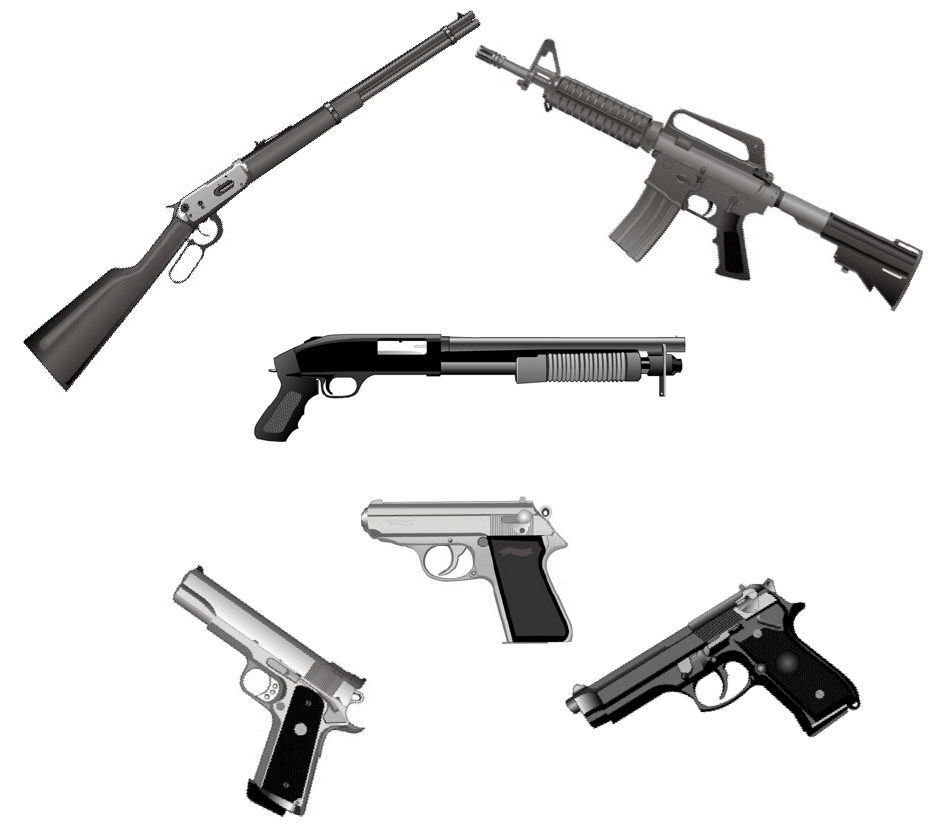
SUMMAR
SUMMAR
Y
Y
OF
OF
FEDERAL
FEDERAL
FIREARMS LA
FIREARMS LA
WS
WS
OFFICE OF THE UNITED STATES ATTORNEY
DISTRICT OF MAINE
SEPTEMBER 2010

Summary Of Federal Firearms Laws—September 2010
INTRODUCTION
Maine has historically had a violent crime rate well below the national average. Nonetheless, every effort
must be made to further reduce violence to ensure that we are safe on our streets and in our homes. Because
the causes of violence in Maine and in society generally are numerous and varied, the solutions require a
concerted national and local effort.
To that end, the Department of Justice and the U.S. Attorney’s Office in Maine have instituted Project Safe
Neighborhoods (PSN Maine), an initiative designed to reduce gun violence in Maine. A PSN Task Force
including representatives from local and state law enforcement, domestic violence groups, schools, civic
groups and business works to develop a comprehensive strategy to address this issue. Part of this strategy
includes support for violent crime task forces in Lewiston and Bangor and an aggressive enforcement policy
for gun crimes.
The federal government has generally lacked jurisdiction to prosecute many violent crimes. Accordingly, the
burden has traditionally fallen upon state and local law enforcement officers and prosecutors. However,
Congress has increasingly broadened federal jurisdiction which enables federal agents and federal prosecutors
to become more involved in the enforcement effort against violence.
This document is designed to be a concise summary of some of the federal statutes which can be used to
prosecute violent offenders. It is not all-inclusive; however, it describes the principal statutes available. By
distributing this information, we hope to generate referrals of cases to our office or the appropriate federal
agency and hence assist state prosecutors and law enforcement personnel in their efforts to combat violent
crime within our state. Please do not hesitate to contact my office if you have any questions about the
applicability of any of these statutes to specific situations.
Thomas E. Delahanty II
United States Attorney
2

Summary Of Federal Firearms Laws—September 2010
FREQUENTLY ENCOUNTERED FEDERAL FIREARM OFFENSES
Definition of a Firearm
For purposes of § 922 and § 924 violations 18 U.S.C. § 921(a)(3) defines a "firearm" as:
A. any weapon (including a starter gun) which will or is designed to or may readily be converted to
expel a projectile by the action of an explosive;
B. the frame or receiver of any such weapon;
C. any firearm muffler or firearm silencer; or
D. any destructive device. Such term does not include an antique firearm.
This broad definition encompasses not only operable firearms but those that have been disassembled or
dismantled or altered in such a way that they are inoperable at the time of the offense. For example, this
definition has been found to include a firearm with the hammer filed down because it could be "readily
converted" to expel a projectile. United States v. Ruiz, 986 F.2d 905 (5th Cir. 1993). This same justification
applies for including starter guns within the definition of a firearm. "Firearm" is defined differently for
violations of 26 U.S.C. § 5861. See 26 U.S.C. § 5845(a) and Appendix.
Possession of Prohibited Firearms
While there are a number of exceptions, federal law prohibits the possession of firearms with obliterated
serial numbers and machine guns manufactured after May 19, 1986. See 18 U.S.C. § 922 (k), (o). In
addition, unless registered to the possessor in the National Firearms Registration and Transfer Record, it is
generally unlawful to possess short-barreled shotguns (defined as one with a barrel length of less than 18" or
overall length less than 26"), short-barreled rifles (defined as one with a barrel length of less than 16" or
overall length less than 26"), machine guns, silencers, and destructive devices. See 26 U.S.C. §§ 5845, 5861.
Penalties for Possessing a Prohibited Firearm
The statutory maximum for knowingly possessing a firearm with an altered serial number is five years and/or
$250,000. 18 U.S.C. § 924 (a)(1)(B). Under the sentencing guidelines, a defendant with no prior record and
one gun would likely receive approximately 15-21 months for possessing a sawed-off shotgun or a firearm
with an altered serial number. A defendant with a substantial record including at least one conviction for drug
trafficking or a crime of violence is eligible for a sentence of approximately 70-87 months for the same
offense. Possessing an unregistered silencer, short barreled rifle, short barreled shotgun, destructive device or
a sawed-off shotgun is punishable by a fine of up to $10,000 and/or 10 years in prison. 26 U.S.C. § 5871. For
the possession of a machine gun manufactured after May 19, 1986, the statutory maximum is 10 years and/or
$250,000. 18 U.S.C. § 924(a)(2).
3

Summary Of Federal Firearms Laws—September 2010
Possession of Firearms by Prohibited Person
Possession of a firearm by a "prohibited person" is illegal. Under 18 U.S.C. § 922 (g) there are nine
categories of prohibited persons. Generally, they include:
felons;
fugitives;
unlawful users of or addicts to a controlled substance;
persons who have been adjudicated as mentally "defective" or who have been involuntarily
committed to a mental institution;
illegal aliens and non-immigrant aliens;
persons dishonorably discharged from the armed forces;
persons who have renounced their U.S. citizenship;
persons who are the subject of a qualifying domestic protection order; and
persons convicted of a misdemeanor crime of domestic violence.
A prohibited person cannot possess, ship, transport or receive a firearm or ammunition that has traveled in
interstate commerce. While this booklet cannot cover every nuance of these categories, some clearly warrant
further explanation.
Felon in possession - 18 U.S.C. § 922(g)(1)
Felon in possession charges are considered for all individuals in possession of firearms who have been
previously convicted of a felony and special attention is given to individuals who have been convicted of
crimes of violence or serious drug transactions. Under this category, generally anyone who has been
convicted of a crime punishable by more than one year in prison is a prohibited person. Similarly, a person
under indictment for a crime punishable by more than a year is prohibited from receiving a firearm. 18 U.S.C.
§ 922 (n).
In federal court, it is not enough to merely introduce a prior conviction — you must show that the defendant
is the individual convicted. This can be done through stipulation, fingerprint or signature cards, date of birth
or social security number, and testimony of the arresting officer for the prior charge, or the testimony of the
defendant's parole or probation officer.
Unlawful user of or addict to a controlled substance
18 U.S.C. § 922 (g) (3) and case law do not provide clear guidance on who is considered to be an unlawful
user of or addict to a controlled substance. The Bureau of Alcohol, Tobacco, Firearms and Explosives
regulations require that the use must have occurred "recently enough to indicate that the individual is actively
4

Summary Of Federal Firearms Laws—September 2010
engaged in such conduct." 27 C.F.R. pt 178.11.
While case law is limited in this area, most cases have reached a similar conclusion. Several early cases
claimed that the statute is unconstitutionally vague because it fails to define a period during which the drug
use and the possession of the firearm must have occurred. United States v. Reed, 114 F.3d 1067, 1071 (10th
Cir. 1997) held that the judicially created requirement of a temporal nexus is sufficient to overcome the
vagueness of the statute. Courts now examine the "pattern and recency" of the defendant's drug use in
determining if there is a temporal nexus between the possession of the firearm and drug use.
Obviously, the easiest method of demonstrating drug use is to question the defendant regarding his or her
drug use habits." Use" also may be demonstrated through drug tests and arrest records. If a defendant is found
with a small quantity of drugs and a gun, good police work is essential in determining the most appropriate
charge. If the defendant says that drugs are only for personal use, he or she may be charged under § 922(g)
(3). If the defendant is a distributor, then § 924 (c) may apply.
Domestic violence prohibitions, 18 U.S.C. §§ 922(g)(8) and (g)(9)
Congress passed the domestic violence-related firearm prohibitions (18 U.S.C. §§ 922(g)(8) and
(g)(9)) out of concern for the number of domestic violence assaults that can and do escalate into firearm
homicides and out of a hope that keeping domestic violence perpetrators from possessing guns would save
the lives of victims of domestic violence. The U.S. Attorney's Office has made a commitment to prosecuting
domestic violence-based federal gun violations, including violations of 18 U.S.C. § 922(g)(8) - possession of
a firearm by a person under a qualifying protection order, and 18 U.S.C. § 922 (g)(9) - possession of a firearm
by a person convicted of a misdemeanor crime of domestic violence. Questions regarding the applicability of
these provisions should be referred to an Assistant United States Attorney.
Penalties for Possession by A Prohibited Person
Absent sentencing enhancements for armed career criminals, 18 U.S.C. § 924(a)(2) provides that the
maximum penalty for most prohibited persons in possession of a firearm is 10 years and $250,000. The
outcome in most cases will be determined by the sentencing guidelines. A prohibited person who is found in
possession of one gun but who has no prior record will likely receive approximately 15-21 months. A
prohibited person with a substantial record that includes one conviction for a crime of violence or drug
trafficking is eligible for a sentence of approximately 70-87 months.
Armed career criminals receive enhanced penalties in the federal system. This office considers the
prosecution of armed career criminals to be of the highest importance. An armed career criminal is a person
who has three or more convictions for a serious drug offense or a felony crime of violence, which includes
crimes that have, as an element, the use, attempted use or threatened use of physical force against the person
of another. A defendant who falls into this category faces a mandatory minimum of 15 years imprisonment
under 18 U.S.C. § 924(e).
5

Summary Of Federal Firearms Laws—September 2010
The Commerce Clause and a Prohibited Person
In order to establish federal jurisdiction in § 922 cases, the gun involved must have traveled in interstate or
foreign commerce. For firearms cases the prosecutor needs to show only that the firearm or ammunition
crossed a state line at some point in its history. For example, if the firearm was manufactured in Michigan
and is recovered in Maine, the interstate nexus requirement has been satisfied. If the firearm was made in
Maine and recovered in Maine, but the prosecutor can demonstrate that it was used to commit a crime in
Maryland 10 years ago, this too will suffice.
The best way to establish that the gun has traveled in interstate commerce is to contact the Bureau of Alcohol,
Tobacco, Firearms and Explosives, which can trace crime guns to determine where they were manufactured
and sold.
Firearm Used in Drug Trafficking or to Commit a Crime of Violence
The prosecution of defendants who use a firearm in connection with a crime of violence or with a drug
trafficking crime is a priority for this office. A person who "uses or carries" a firearm during or in relation to,
or possesses a firearm "in furtherance of," drug trafficking or a crime of violence that can be prosecuted in
federal court may receive enhanced penalties under 18 U.S.C. § 924 (c). Most of the cases arising out of this
statute have centered on the definitions of "use," carry," and "in furtherance of." In a recent, unpublished
First Circuit opinion (United States v. Dolliver, July 2007), the Court found that bartering drugs for firearms
was sufficient to prove a violation of §924(c)(1)(A)(i).
Meaning of "Use" under § 924(c)
Courts have determined that "use" of a firearm requires something more than mere possession; it requires
active employment of the weapon. Bailey v. United States, 516 U.S. 137, 149 (1995) defines active
employment to include: "brandishing, displaying, battering, striking with, and most obviously, firing or
attempting to fire a firearm." The Bailey court also notes that "use" can mean "to convert to one's service,"
"employ," "avail oneself of," and to make "reference to" if referring to the firearm is calculated to make the
transaction easier.
For example, a drug dealer who keeps a firearm in the closet during a drug transaction cannot be said to have
"used" the firearm unless he makes reference to the weapon during the transaction. However, this same
section also prohibits possession of a firearm "in furtherance of " drug trafficking. Under the "fortress
theory," if the defendant uses a firearm to protect the house in which drugs or the proceeds of drugs are kept,
he could be guilty of possession in furtherance of drug trafficking.
Meaning of "Carry" under § 924(c)
The federal circuits have varying definitions of "carry." All circuits agree that carrying requires knowing
possession and transportation of the firearm. United States v. Mitchell, 104 F.3d 494, 653 (4th Cir. 1997).
6

Summary Of Federal Firearms Laws—September 2010
However, the First, Second, Sixth and Ninth circuits also require that the firearm be readily accessible. See
United States v. Ramirez-Ferrer, 82 F.3d 1149, 1153-4 (1st Cir. 1996); United States v. Cruz-Rojas, 101 F.3d
283 (2d Cir. 1996); United States v. Riascos-Suarez, 73 F.3d 616, 623 (6th Cir. 1996); United States v.
Hernandez, 80 F.3d 1253, 1257-8 (9th Cir. 1996). In a jurisdiction that requires that the firearm be
accessible, transporting a gun in the trunk of a car will not qualify as carrying because the defendant does not
have easy access to the weapon.
Meaning of "in furtherance of"
One of the principal cases in determining the definition and scope of "in furtherance of" is United States v.
Ceballos-Torres, 218 F.3d 409 (5th Cir. 2002). Possession of a firearm is "in furtherance of" a drug
trafficking crime "when it furthers, advances, or helps forward that offense." Id. at 411.
First, an accessible gun provides defense against anyone who may attempt to rob the trafficker of his drugs
or drug profits. Second, possession of a gun, and letting everyone know that you are armed, lessens the
chance that a robbery will even be attempted. Third, having a gun accessible during a transaction provides
protection in case a drug deal in the apartment turns sour. Fourth, the visible presence of a gun during the
transaction may prevent the deal from turning sour in the first place. Fifth, having a gun may allow the drug
trafficker to defend ‘turf,' areas of the street from which lower level dealers operate for the trafficker. There
may be other ways. Id. at 412.
§ 924 (c) Does Not Require The Gun to Have Traveled in Interstate Commerce
Because the underlying offense (drug trafficking or a crime of violence over which there is federal
jurisdiction) is prosecutable in federal court, there is no interstate nexus requirement for the gun itself.
The Penalties for a Violation of § 924(c)
Penalties under this section vary depending on the type of firearm, how the firearm was used and whether the
offense is the defendant's first violation. All sentences under this section must be served consecutively to any
Offense Penalty
Standard case Not less than 5 years
Brandishing the firearm Not less than 7 years
Discharging the firearm Not less than 10 years
A short barreled rifle or shotgun Not less than 10 years
A machine gun, destructive device or silencer Not less than 30 years
Second or subsequent conviction Not less than 25 years
Second or subsequent conviction and the gun is
a machine gun, destructive device or silencer
LIFE
7

Summary Of Federal Firearms Laws—September 2010
Offense Penalty
Standard case Not less than 5 years
Brandishing the firearm Not less than 7 years
Discharging the firearm Not less than 10 years
A short barreled rifle or shotgun Not less than 10 years
A machine gun, destructive device or silencer Not less than 30 years
Second or subsequent conviction Not less than 25 years
Second or subsequent conviction and the gun is
a machine gun, destructive device or silencer
LIFE
other sentence, and offenders are not eligible for probation. Under federal law, the second conviction does
not have to be the result of a separate incident.
BRADY ACT
The Brady Act obligates law enforcement officials to conduct background checks before someone can
purchase a handgun from a gun dealer. Under the Brady Act, it is unlawful for any licensed dealer to sell,
deliver or transfer a handgun to an individual who is not licensed unless there is compliance with the Brady
Act waiting period. Violation of this statute carries a penalty of not more than one year imprisonment, as
well as a $1,000 fine. See 18 U.S.C. §§922(s)(1) and 924(a)(5).
Also, any person who makes a false statement to a licensed dealer in connection with the acquisition of a
firearm shall be punished by imprisonment for no more than ten years. See 18 U.S.C. §§922(a)(6) and 924(a)
(2). A false statement can include:
name, age, address, date of birth, identification number, and status as convicted felon, fugitive, unlawful user
of or addict to controlled substance, prior commitment to a mental institution, illegal alien, dishonorable
discharge from the military, status as U.S. citizen who has renounced citizenship, being subject to certain
protection orders and having been convicted of a misdemeanor crime of domestic violence. False statements
can also include the representation that the purchaser is the real intended owner of the firearm when the
purchaser is actually making a "straw" purchase for someone else.
Although this is a crime separate and apart from the Brady Act, every time a Brady background check
establishes that a handgun should not be sold to the prospective purchaser, the prospective purchaser has
falsified the form and, accordingly, the false statement statute has been violated.
DRUG-RELATED HOME INVASIONS
Armed drug-related robberies, especially home invasion robberies, are appropriate cases for federal
8

Summary Of Federal Firearms Laws—September 2010
prosecution and will be prosecuted where federal jurisdiction exists and where acceptable sentencing criteria
are present. Federal jurisdiction can be predicated on the commission of a drug offense as part of the robbery
or on the armed defendant's felony record. For example, where two or more people agree to break into a
home and steal a distributable quantity of drugs, they have committed a drug conspiracy. If a gun is carried
in the execution of the plan, they have violated 18 U.S.C. §924(c), which carries a mandatory five-year
sentence consecutive to any other sentence imposed. If the robber is a felon, the case is prosecutable as a
firearm felon case.
Home invasion cases that are accepted for federal prosecution include those in which the defendant is an
armed career criminal, a career offender or a major drug dealer. In addition, most cases in which there is a
provable 924(c) case will be accepted for federal prosecution.
COMMERCIAL ROBBERIES - HOBBS ACT, 18 U.S.C. § 1951
It is against federal law to interfere with interstate commerce by means of extortion or robbery. The Hobbs
Act, 18 U.S.C. §1951, is a traditional tool in combating organized crime. However, prosecution under the
Hobbs Act is also available where the defendant interferes with commerce by means of a robbery. If a person
robs a business that is engaged in interstate commerce, then it is possible to charge that individual with a
violation of the Hobbs Act. Of course, if the robber in any particular situation carries or uses a firearm in the
commission of the offense, we also have the traditional firearms statutes which can be used to prosecute the
violator federally. To the extent permissible, our office will vigorously prosecute anyone who uses a firearm
in the commission of a robbery.
THREE STRIKES, 18 U.S.C. 3559(c)
The Violent Crime Control Act requires life imprisonment (without possibility of parole) for federal
offenders convicted of a serious violent felony after two or more federal or state convictions for a serious
violent felony or for a serious violent felony and a serious drug offense. To count toward "three strikes", the
convictions must have occurred on separate occasions from each other, and each countable offense (other
than the first) must have been committed after the defendant's conviction for the preceding one. Convictions
prior to the date of the enactment of the Violent Crime Control Act, September 13, 1994, count as strikes.
The third strike must occur after the date of the enactment of the Act.
The statute defines "serious violent felony" to include such offenses as murder, rape and kidnapping. The
statute defines "serious drug offense" to include large-scale drug transactions and continuing criminal
enterprise. Specific questions regarding the applicability of this provision of the Violent Crime Control Act
should be referred to an Assistant United States Attorney.
9

Summary Of Federal Firearms Laws—September 2010
JUVENILES
Youth Handgun Safety, 18 U.S.C. § 922(x)
The Violent Crime Control Act makes it a federal offense for a juvenile under 18 years of age to knowingly
possess a handgun or handgun ammunition. The Act also makes it unlawful to transfer a handgun or handgun
ammunition to a person the transferor knows or has reasonable cause to believe is under 18 years of age.
The above provisions are subject to a number of exceptions, such as for the armed forces, ranching, farming,
hunting and other specified uses. Some exceptions require the juvenile to be in possession of the prior
written consent of his or her parent or guardian. The penalty for possession of a handgun or handgun
ammunition by a juvenile is probation if the juvenile has never been convicted of an offense or adjudicated a
juvenile delinquent for an offense. Otherwise, the maximum penalty for a juvenile is one year of
imprisonment.
The penalty for an adult who transfers a handgun or handgun ammunition to a juvenile is ordinarily a
maximum of one year of imprisonment. However, if the violator knew or had reasonable cause to know that
the juvenile intended to possess or use a handgun or ammunition in a crime of violence, the maximum
penalty is 10 years imprisonment.
Guns In School, 18 U.S. C. § 922(q)(2)(A)
Since the inception of Project Sentry, this office has dedicated one Assistant United States Attorney to the
prosecution of juveniles who illegally possess firearms and adults who provide such weapons to juveniles.
The reduction of gun violence and gun possession in schools is also a priority of this office.
Accordingly, any individual who knowingly possesses a firearm at a place that the individual knows, or has
reasonable cause to believe, is a school zone (on school grounds or public property within 1,000 feet of
school grounds) violates 18 U.S. C. § 922(q)(2)(A) and faces a maximum of five years imprisonment. See
enumerated exceptions listed in § 922(q)(2)(A).
Adult Prosecution of Juveniles
The Violent Crime Control Act amends the current law to permit adult prosecution of 13-and 14-year-olds
charged with certain crimes of violence, including robbery or aggravated sexual abuse committed with a
firearm. The Act also adds several serious firearms offenses to those for which a juvenile can be prosecuted
as an adult. Another provision of the Act requires the court to consider, in determining whether a juvenile
should be tried as an adult, the extent to which the juvenile played a leadership role in an organization, or
otherwise influenced others to take part in criminal activities involving the use or distribution of drugs or
firearms.
As a practical matter, since the United States Government lacks facilities for juveniles, prosecution of a
juvenile in federal court will be the exception and not the rule. To the extent practicable juveniles who
10

Summary Of Federal Firearms Laws—September 2010
commit violent crimes with firearms will be prosecuted federally. Questions concerning federal prosecution
of juveniles should be addressed to an Assistant United States Attorney on a case-by-case basis.
CONTACTS
Our office telephone numbers and the names of supervisory attorneys are:
U.S. Attorney's Office
Portland: (207) 780-3257
Thomas E. Delahanty II, United States Attorney
Richard W. Murphy, First Assistant U.S. Attorney
Jonathan R. Chapman, Chief, Criminal Division
Darcie McElwee, AUSA, Project Safe Neighborhoods/Sentry/Anti-Gang Coordinator
Heather Putnam, Victim Witness Coordinator/Law Enforcement Coordinator
Bangor: (207) 945-0373
F. Todd Lowell, AUSA, Bangor Branch Manager
Gail Fisk Malone, AUSA, Violence Against Women Act Point-of-Contact
Marilyn DiBonaventuro, Victim Witness Assistant
Violent Crimes Task Forces
Eastern Maine Violent Crime Task Force (207) 262-6046
Todd Lowell, AUSA (207) 945-0373
Aroostook County, Franklin County, Hancock County, Kennebec County, Piscataquis
County, Penobscot County, Somerset County, Waldo County, Washington County
Central Maine Violent Crime Task Force (207) 786-8050
Darcie McElwee, AUSA (207) 771-3227
Androscoggin County, Cumberland County, Knox County, Lincoln County, Oxford
County, Sagadahoc County, York County
Federal Agencies
ATF: (207) 780-3324 (Portland)
(207) 262-6046 (Bangor)
DEA: (207) 780-3331 (Portland)
(207) 262-4666 (Bangor)
FBI: (207) 774-9322 (Portland)
(207) 947-6670 (Bangor)
(207) 622-2902 (Augusta)
USMS: (207) 780-3355 (Portland)
(207) 945-0416 (Bangor)
11

Summary Of Federal Firearms Laws—September 2010
As we have noted throughout, any questions regarding the applicability of any of these statutes to
specific situations should be referred to the U.S. Attorney or an Assistant U.S. Attorney. By distributing this
information, we hope to generate referrals of appropriate cases to our office, the violent crime task forces or
the appropriate federal agency, and, through the imposition of significant federal sentences, assist state
prosecutors and law enforcement personnel in their efforts to combat violent crime within our state.
APPENDIX
18 U.S.C. § 842. Unlawful Acts: Explosives
(a) It shall be unlawful for any person -
(1) to engage in the business of importing, manufacturing, or dealing in explosive materials without
a license issued under this chapter;
(2) knowingly to withhold information or to make any false or fictitious oral or written statement or
to furnish or exhibit any false, fictitious, or misrepresented identification, intended or likely to
deceive for the purpose of obtaining explosive materials, or a license, permit, exemption, or relief
from disability under the provisions of this chapter; and
(3) other than a licensee or permittee knowingly -
(A) to transport, ship, cause to be transported, or receive in interstate or foreign commerce any
explosive materials, except that a person who lawfully purchases explosive materials from a
licensee in a State contiguous to the State in which the purchaser resides may ship, transport, or
cause to be transported such explosive materials to the State in which he resides and may
receive such explosive materials in the State in which he resides, if such transportation,
shipment, or receipt is permitted by the law of the State in which he resides; or
(B) to distribute explosive materials to any person (other than a licensee or permittee) who the
distributor knows or has reasonable cause to believe does not reside in the State in which the
distributor resides.
(b) It shall be unlawful for any licensee knowingly to distribute any explosive materials to any person except:
(1) a licensee;
(2) a permittee; or
(3)a resident of the State where distribution is made and in which the licensee is licensed to do
business or a State contiguous thereto if permitted by the law of the State of the purchaser's
residence.
(c) It shall be unlawful for any licensee to distribute explosive materials to any person who the licensee has
reason to believe intends to transport such explosive materials into a State where the purchase, possession, or
use of explosive materials is prohibited or which does not permit its residents to transport or ship explosive
materials into it or to receive explosive materials in it.
12

Summary Of Federal Firearms Laws—September 2010
(d) It shall be unlawful for any person knowingly to distribute explosive materials to any individual who:
(1) is under twenty-one years of age;
(2) has been convicted in any court of a crime punishable by imprisonment for a term exceeding one
year;
(3) is under indictment for a crime punishable by imprisonment for a term exceeding one year;
(4) is a fugitive from justice;
(5) is an unlawful user of or addicted to any controlled substance (as defined in section 102 of the
Controlled Substances Act (21 U.S.C. 802)); or
(6) has been adjudicated a mental defective.
(e) It shall be unlawful for any licensee knowingly to distribute any explosive materials to any person in any
State where the purchase, possession, or use by such person of such explosive materials would be in violation
of any State law or any published ordinance applicable at the place of distribution.
(f) It shall be unlawful for any licensee or permittee willfully to manufacture, import, purchase, distribute, or
receive explosive materials without making such records as the Secretary may by regulation require,
including, but not limited to, a statement of intended use, the name, date, place of birth, social security
number or taxpayer identification number, and place of residence of any natural person to whom explosive
materials are distributed. If explosive materials are distributed to a corporation or other business entity, such
records shall include the identity and principal and local places of business and the name, date, place of birth,
and place of residence of the natural person acting as agent of the corporation or other business entity in
arranging the distribution.
(g) It shall be unlawful for any licensee or permittee knowingly to make any false entry in any record which
he is required to keep pursuant to this section or regulations promulgated under section 847 of this title.
(h) It shall be unlawful for any person to receive, possess, transport, ship, conceal, store, barter, sell, dispose
of, or pledge or accept as security for a loan, any stolen explosive materials which are moving as, which are
part of, which constitute, or which have been shipped or transported in, interstate or foreign commerce, either
before or after such materials were stolen, knowing or having reasonable cause to believe that the explosive
materials were stolen.
(i) It shall be unlawful for any person -
(1) who is under indictment for, or who has been convicted in any court of, a crime punishable by
imprisonment for a term exceeding one year;
(2) who is a fugitive from justice;
(3) who is an unlawful user of or addicted to any controlled substance (as defined in section 102 of
the Controlled Substances Act (21 U.S.C. 802)); or
(4) who has been adjudicated as a mental defective or who has been committed to a mental
institution;
13

Summary Of Federal Firearms Laws—September 2010
(5) to ship or transport any explosive in interstate or foreign commerce or to receive or possess any
explosive which has been shipped or transported in interstate or foreign commerce.
(j) It shall be unlawful for any person to store any explosive material in a manner not in conformity with
regulations promulgated by the Secretary. In promulgating such regulations, the Secretary shall take into
consideration the class, type, and quantity of explosive materials to be stored, as well as the standards of
safety and security recognized in the explosives industry.
(k) It shall be unlawful for any person who has knowledge of the theft or loss of any explosive materials from
his stock, to fail to report such theft or loss within twenty-four hours of discovery thereof, to the Secretary
and to appropriate local authorities.
(l) It shall be unlawful for any person to manufacture any plastic explosive that does not contain a detection
agent.
(m) (1) It shall be unlawful for any person to import or bring into the United States, or export
from the United States, any plastic explosive that does not contain a detection agent.
(2) This subsection does not apply to the importation or bringing into the United States, or the
exportation from the United States, of any plastic explosive that was imported or brought into, or
manufactured in the United States prior to the date of enactment of this subsection by or on behalf of
any agency of the United States performing military or police functions (including any military
reserve component) or by or on behalf of the National Guard of any State, not later than 15 years
after the date of entry into force of the Convention on the Marking of Plastic Explosives, with
respect to the United States.
(n) (1) It shall be unlawful for any person to ship, transport, transfer, receive, or possess any
plastic explosive that does not contain a detection agent.
(2) This subsection does not apply to -
(A) the shipment, transportation, transfer, receipt, or possession of any plastic explosive that
was imported or brought into, or manufactured in the United States prior to the date of
enactment of this subsection by any person during the period beginning on that date and ending
3 years after that date of enactment; or
(B) the shipment, transportation, transfer, receipt, or possession of any plastic explosive that
was imported or brought into, or manufactured in the United States prior to the date of
enactment of this subsection by or on behalf of any agency of the United States performing a
military or police function (including any military reserve component) or by or on behalf of the
National Guard of any State, not later than 15 years after the date of entry into force of the
Convention on the Marking of Plastic Explosives, with respect to the United States.
(o) It shall be unlawful for any person, other than an agency of the United States (including any military
reserve component) or the National Guard of any State, possessing any plastic explosive on the date of
enactment of this subsection, to fail to report to the Secretary within 120 days after such date of enactment the
quantity of such explosives possessed, the manufacturer or importer, any marks of identification on such
explosives, and such other information as the Secretary may prescribe by regulation.
14

Summary Of Federal Firearms Laws—September 2010
(p) Distribution of Information Relating to Explosives, Destructive Devices, and Weapons of Mass
Destruction. -
(1) Definitions. - In this subsection -
(A) the term ''destructive device'' has the same meaning as in section 921(a)(4);
(B) the term ''explosive'' has the same meaning as in section 844(j); and
(C) the term ''weapon of mass destruction'' has the same meaning as in section 2332a
(c)(2).
(2) Prohibition. - It shall be unlawful for any person -
(A) to teach or demonstrate the making or use of an explosive, a destructive device,
or a weapon of mass destruction, or to distribute by any means information pertaining
to, in whole or in part, the manufacture or use of an explosive, destructive device, or
weapon of mass destruction, with the intent that the teaching, demonstration, or
information be used for, or in furtherance of, an activity that constitutes a Federal
crime of violence; or
(B) to teach or demonstrate to any person the making or use of an explosive, a
destructive device, or a weapon of mass destruction, or to distribute to any person, by
any means, information pertaining to, in whole or in part, the manufacture or use of an
explosive, destructive device, or weapon of mass destruction, knowing that such
person intends to use the teaching, demonstration, or information for, or in
furtherance of, an activity that constitutes a Federal crime of violence.
18 U.S.C. § 921. Definitions
(a) As used in this chapter -
…
(3) The term "firearm'' means (A) any weapon (including a starter gun) which will or is
designed to or may readily be converted to expel a projectile by the action of an explosive;
(B) the frame or receiver of any such weapon; (C) any firearm muffler or firearm silencer;
or (D) any destructive device. Such term does not include an antique firearm.
(4) The term "destructive device'' means -
(A) any explosive, incendiary, or poison gas -
a. bomb,
b. grenade,
(iii) rocket having a propellant charge of more than four ounces,
15

Summary Of Federal Firearms Laws—September 2010
(iv) missile having an explosive or incendiary charge of more than one-quarter
ounce,
(v) mine, or
(vi) device similar to any of the devices described in the preceding clauses;
(B) any type of weapon (other than a shotgun or a shotgun shell which the Secretary finds is
generally recognized as particularly suitable for sporting purposes) by whatever name
known which will, or which may be readily converted to, expel a projectile by the action of
an explosive or other propellant, and which has any barrel with a bore of more than one-
half inch in diameter; and
(C) any combination of parts either designed or intended for use in converting any device
into any destructive device described in subparagraph (A) or (B) and from which a
destructive device may be readily assembled. The term "destructive device'' shall not
include any device which is neither designed nor redesigned for use as a weapon; any
device, although originally designed for use as a weapon, which is redesigned for use as a
signaling, pyrotechnic, line throwing, safety, or similar device; surplus ordnance sold,
loaned, or given by the Secretary of the Army pursuant to the provisions of section 4684(2),
4685, or 4686 of title 10; or any other device which the Secretary of the Treasury finds is
not likely to be used as a weapon, is an antique, or is a rifle which the owner intends to use
solely for sporting, recreational or cultural purposes.
(5) The term "shotgun'' means a weapon designed or redesigned made or remade, and intended to be
fired from the shoulder and designed or redesigned and made or remade to use the energy of an
explosive to fire through a smooth bore either a number of ball shot or a single projectile for each
single pull of the trigger.
(6) The term "short-barreled shotgun'' means a shotgun having one or more barrels less than eighteen
inches in length and any weapon made from a shotgun (whether by alteration, modification or
otherwise) if such a weapon as modified has an overall length of less than twenty-six inches.
(7) The term "rifle'' means a weapon designed or redesigned, made or remade, and intended to be
fired from the shoulder and designed or redesigned and made or remade to use the energy of an
explosive to fire only a single projectile through a rifled bore for each single pull of the trigger.
(8) The term "short-barreled rifle'' means a rifle having one or more barrels less than sixteen inches
in length and any weapon made from a rifle (whether by alteration, modification, or otherwise) if
such weapon, as modified, has an overall length of less than twenty- six inches.
...
(14) The term "indictment" includes an indictment or information in any court under which a crime
punishable by imprisonment for a term exceeding one year may be prosecuted.
(15) The term "fugitive from justice'' means any person who has fled from any State to avoid
prosecution for a crime or to avoid giving testimony in any criminal proceeding.
...
16

Summary Of Federal Firearms Laws—September 2010
(17) (A) The term "ammunition'' means ammunition or cartridge cases, primers, bullets,
or propellant powder designed for use in any firearm.
(B) The term "armor piercing ammunition'' means -
(i) a projectile or projectile core which may be used in a handgun and which is
constructed entirely (excluding the presence of traces of other substances) from
one or a combination of tungsten alloys, steel, iron, brass, bronze, beryllium
copper, or depleted uranium; or
(ii) a full jacketed projectile larger than .22 caliber designed and intended for use
in a handgun and whose jacket has a weight of more than 25 percent of the total
weight of the projectile.
(C) The term "armor piercing ammunition'' does not include shotgun shot required by
Federal or State environmental or game regulations for hunting purposes, a frangible
projectile designed for target shooting, a projectile which the Secretary finds is primarily
intended to be used for sporting purposes, or any other projectile or projectile core which
the Secretary finds is intended to be used for industrial purposes, including a charge used in
an oil and gas well perforating device.
...
(20) The term "crime punishable by imprisonment for a term exceeding one year" does not include -
(A) any Federal or State offenses pertaining to antitrust violations, unfair trade practices,
restraints of trade, or other similar offenses relating to the regulation of business practices,
or
(B) any State offense classified by the laws of the State as a misdemeanor and punishable
by a term of imprisonment of two years or less. What constitutes a conviction of such a
crime shall be determined in accordance with the law of the jurisdiction in which the
proceedings were held. Any conviction which has been expunged, or set aside or for which
a person has been pardoned or has had civil rights restored shall not be considered a
conviction for purposes of this chapter, unless such pardon, expungement, or restoration of
civil rights expressly provides that the person may not ship, transport, possess, or receive
firearms.
...
(23) The term "machine gun" has the meaning given such term in section 5845(b) of the National
Firearms Act (26 U.S.C. 5845(b)).
(24) The terms "firearm silencer" and "firearm muffler" mean any device for silencing, muffling, or
diminishing the report of a portable firearm, including any combination of parts, designed or
redesigned, and intended for use in assembling or fabricating a firearm silencer or firearm muffler,
and any part intended only for use in such assembly or fabrication.
...
17

Summary Of Federal Firearms Laws—September 2010
(28) The term "semi-automatic rifle" means any repeating rifle which utilizes a portion of the energy
of a firing cartridge to extract the fired cartridge case and chamber the next round, and which
requires a separate pull of the trigger to fire each cartridge.
(29) The term "handgun" means -
(A) a firearm which has a short stock and is designed to be held and fired by the use of a
single hand; and
(B) any combination of parts from which a firearm described in subparagraph (A) can be
assembled.
...
(32) The term "intimate partner'' means, with respect to a person, the spouse of the person, a former
spouse of the person, an individual who is a parent of a child of the person, and an individual who
cohabitates or has cohabited with the person.
(33)(A) Except as provided in subparagraph (C), the term "misdemeanor crime of domestic
violence'' means an offense that -
(i) is a misdemeanor under Federal or State law; and
(ii) has, as an element, the use or attempted use of physical force, or the threatened use of
a deadly weapon, committed by a current or former spouse, parent, or guardian of the
victim, by a person with whom the victim shares a child in common, by a person who is
cohabiting with or has cohabited with the victim as a spouse, parent, or guardian, or by a
person similarly situated to a spouse, parent, or guardian of the victim.
...
18 U.S.C. § 922. Unlawful acts
(g) It shall be unlawful for any person -
(1) who has been convicted in any court of, a crime punishable by imprisonment for a term
exceeding one year;
(2) who is a fugitive from justice;
(3) who is an unlawful user of or addicted to any controlled substance (as defined in section 102 of
the Controlled Substances Act (21 U.S.C. 802));
(4) who has been adjudicated as a mental defective or who has been committed to a mental
institution;
(5) who, being an alien -
(A) is illegally or unlawfully in the United States; or
18

Summary Of Federal Firearms Laws—September 2010
(B) except as provided in subsection (y)(2), has been admitted to the United States under
a non-immigrant visa (as that term is defined in section 101(a)(26) of the Immigration and
Nationality Act (8 U.S.C. 1101(a)(26)));
(6) who has been discharged from the Armed Forces under dishonorable conditions;
(7) who, having been a citizen of the United States, has renounced his citizenship;
(8) who is subject to a court order that -
(A) was issued after a hearing of which such person received actual notice, and at which
such person had an opportunity to participate;
(B) restrains such person from harassing, stalking, or threatening an intimate partner of
such person or child of such intimate partner or person, or engaging in other conduct that
would place an intimate partner in reasonable fear of bodily injury to the partner or child;
and
(C) (i) includes a finding that such person represents a credible threat to the physical
safety of such intimate partner or child; or
(ii) by its terms explicitly prohibits the use, attempted use, or threatened use of
physical force against such intimate partner or child that would reasonably be
expected to cause bodily injury; or
(9) who has been convicted in any court of a misdemeanor crime of domestic violence, to ship or transport
in interstate or foreign commerce, or possess in or affecting commerce, any firearm or ammunition; or to
receive any firearm or ammunition which has been shipped or transported in interstate or foreign
commerce.
...
(k) It shall be unlawful for any person knowingly to transport, ship, or receive, in interstate or foreign
commerce, any firearm which has had the importer's or manufacturer's serial number removed, obliterated,
or altered or to possess or receive any firearm which has had the importer's or manufacturer's serial number
removed, obliterated, or altered and has, at any time, been shipped or transported in interstate or foreign
commerce.
...
(n) It shall be unlawful for any person who is under indictment for a crime punishable by imprisonment for
a term exceeding one year to ship or transport in interstate or foreign commerce any firearm or ammunition
or receive any firearm or ammunition which has been shipped or transported in interstate or foreign
commerce.
(o) (1) Except as provided in paragraph (2), it shall be unlawful for any person to transfer or
possess a machine gun.
...
(q)(2)(A) It shall be unlawful for any individual knowingly to possess a firearm that has moved in or that
otherwise affects interstate or foreign commerce at a place that the individual knows, or has reasonable
cause to believe, is a school zone.
19

Summary Of Federal Firearms Laws—September 2010
(B) Subparagraph (A) does not apply to the possession of a firearm - (i) on private property not part of school
grounds; (ii) if the individual possessing the firearm is licensed to do so by the State in which the school zone
is located or a political subdivision of the State, and the law of the State or political subdivision requires that,
before an individual obtains such a license, the law enforcement authorities of the State or political
subdivision verify that the individual is qualified under law to receive the license; (iii) that is - (I) not loaded;
and (II) in a locked container, or a locked firearms rack that is on a motor vehicle; (iv) by an individual for
use in a program approved by a school in the school zone; (v) by an individual in accordance with a contract
entered into between a school in the school zone and the individual or an employer of the individual; (vi) by a
law enforcement officer acting in his or her official capacity; or (vii) that is unloaded and is possessed by an
individual while traversing school premises for the purpose of gaining access to public or private lands open
to hunting, if the entry on school premises is authorized by school authorities. (3)(A) Except as provided in
subparagraph (B), it shall be unlawful for any person, knowingly or with reckless disregard for the safety of
another, to discharge or attempt to discharge a firearm that has moved in or that otherwise affects interstate or
foreign commerce at a place that the person knows is a school zone. (B) Subparagraph (A) does not apply to
the discharge of a firearm - (i) on private property not part of school grounds; (ii) as part of a program
approved by a school in the school zone, by an individual who is participating in the program; (iii) by an
individual in accordance with a contract entered into between a school in a school zone and the individual or
an employer of the individual; or (iv) by a law enforcement officer acting in his or her official capacity. (4)
Nothing in this subsection shall be construed as preempting or preventing a State or local government from
enacting a statute establishing gun free school zones as provided in this subsection.
...
(x) (1) It shall be unlawful for a person to sell, deliver, or otherwise transfer to a person who
the transferor knows or has reasonable cause to believe is a juvenile -
(A) a handgun; or
(B) ammunition that is suitable for use only in a handgun.
(2) It shall be unlawful for any person who is a juvenile to knowingly possess -
(A) a handgun; or
(B) ammunition that is suitable for use only in a handgun.
18 U.S.C. § 924. Penalties
(a) (1) Except as otherwise provided in this subsection, subsection (b), (c), or (f) of this section,
or in section 929, whoever -
(A) knowingly makes any false statement or representation with respect to the
information required by this chapter to be kept in the records of a person licensed
under this chapter or in applying for any license or exemption or relief from disability
under the provisions of this chapter;
20

Summary Of Federal Firearms Laws—September 2010
(B) knowingly violates subsection (a)(4), (f), (k) or (r) of section 922;
(C) knowingly imports or brings into the United States or any possession thereof any
firearm or ammunition in violation of section 922(l); or
(D) willfully violates any other provision of this chapter, shall be fined under this title,
imprisoned not more than five years, or both.
(2) Whoever knowingly violates subsection (a)(6), (d), (g), (h), (i), (j), or (o) of section 922 shall be
fined as provided in this title, imprisoned not more than 10 years, or both.
...
(c) (1)
(A) Except to the extent that a greater minimum sentence is otherwise provided by
this subsection or by any other provision of law, any person who, during and in
relation to any crime of violence or drug trafficking crime (including a crime of
violence or drug trafficking crime that provides for an enhanced punishment if
committed by the use of a deadly or dangerous weapon or device) for which the
person may be prosecuted in a court of the United States, uses or carries a firearm, or
who, in furtherance of any such crime, possesses a firearm, shall, in addition to the
punishment provided for such crime of violence or drug trafficking crime -
(i) be sentenced to a term of imprisonment of not less than 5 years;
(ii) if the firearm is brandished, be sentenced to a term of imprisonment of not less
than 7 years; and
(iii) if the firearm is discharged, be sentenced to a term of imprisonment of not less
than 10 years.
(B) If the firearm possessed by a person convicted of a violation of this subsection -
(i) is a short-barreled rifle or short-barreled shotgun, the person shall be sentenced
to a term of imprisonment of not less than 10 years; or
(ii) is a machine gun or a destructive device, or is equipped with a firearm silencer
or firearm muffler, the person shall be sentenced to a term of imprisonment of not
less than 30 years.
(C) In the case of a second or subsequent conviction under this subsection, the person shall -
(i) be sentenced to a term of imprisonment of not less than 25 years; and
(ii) if the firearm involved is a machine gun or a destructive device, or is equipped
with a firearm silencer or firearm muffler, be sentenced to imprisonment for life.
(D) Notwithstanding any other provision of law -
(i) a court shall not place on probation any person convicted of a violation of this
subsection; and
21

Summary Of Federal Firearms Laws—September 2010
(ii) no term of imprisonment imposed on a person under this subsection shall run
concurrently with any other term of imprisonment imposed on the person,
including any term of imprisonment imposed for the crime of violence or drug
trafficking crime during which the firearm was used, carried, or possessed.
(2) For purposes of this subsection, the term "drug trafficking crime'' means any felony punishable
under the Controlled Substances Act (21 U.S.C. 801 et seq.), the Controlled Substances Import and
Export Act (21 U.S.C. 951 et seq.), or the Maritime Drug Law Enforcement Act (46 U.S.C. App.
1901 et seq.)
(3) For purposes of this subsection the term "crime of violence'' means an offense that is a felony
and -
(A) has as an element the use, attempted use, or threatened use of physical force against the
person or property of another, or
(B) that by its nature, involves a substantial risk that physical force against the person or
property of another may be used in the course of committing the offense.
(4) For purposes of this subsection, the term "brandish'' means, with respect to a firearm, to display
all or part of the firearm, or otherwise make the presence of the firearm known to another person, in
order to intimidate that person, regardless of whether the firearm is directly visible to that person.
(e) (1) In the case of a person who violates section 922(g) of this title and has three previous convictions
by any court referred to in section 922(g)(1) of this title for a violent felony or a serious drug
offense, or both, committed on occasions different from one another, such person shall be fined not
more than $25,000 and imprisoned not less than fifteen years, and, notwithstanding any other
provision of law, the court shall not suspend the sentence of, or grant a probationary sentence to,
such person with respect to the conviction under section 922(g).
(2) As used in this subsection -
(A) the term "serious drug offense'' means -
(i) an offense under the Controlled Substances Act (21 U.S.C. 801 et seq.), the
Controlled Substances Import and Export Act (21 U.S.C. 951 et seq.), or the
Maritime Drug Law Enforcement Act (46 U.S.C. App. 1901 et seq.) for which a
maximum term of imprisonment of ten years or more is prescribed by law; or
(ii) an offense under State law, involving manufacturing, distributing, or
possessing with intent to manufacture or distribute, a controlled substance (as
defined in section 102 of the Controlled Substances Act (21 U.S.C. 802)), for
which a maximum term of imprisonment of ten years or more is prescribed by law;
(B) the term "violent felony'' means any crime punishable by imprisonment for a term
exceeding one year, or any act of juvenile delinquency involving the use or carrying of a
firearm, knife, or destructive device that would be punishable by imprisonment for such
term if committed by an adult, that –
(i) has as an element the use, attempted use, or threatened use of physical force
22

Summary Of Federal Firearms Laws—September 2010
against the person of another; or
(ii) is burglary, arson, or extortion, involves use of explosives, or otherwise
involves conduct that presents a serious potential risk of physical injury to another;
and
(C) the term "conviction'' includes a finding that a person has committed an act of juvenile
delinquency involving a violent felony.
(f) In the case of a person who knowingly violates section 922(p), such person shall be fined under this title,
or imprisoned not more than 5 years, or both.
(g) Whoever, with the intent to engage in conduct which -
(1) constitutes an offense listed in section 1961(1),
(2) is punishable under the Controlled Substances Act (21 U.S.C. 802 et seq.), the Controlled
Substances Import and Export Act (21 U.S.C. 951 et seq.), or the Maritime Drug Law Enforcement
Act (46 U.S.C. App. 1901 et seq.),
(3) violates any State law relating to any controlled substance (as defined in section 102(6) of the
controlled Substances Act (21 U.S.C. 802(6))), or
(4) constitutes a crime of violence (as defined in subsection (c)(3)), travels from any State or foreign
country into any other State and acquires, transfers, or attempts to acquire or transfer, a firearm in
such other State in furtherance of such purpose, shall be imprisoned not more than 10 years, fined in
accordance with this title, or both.
...
(o) A person who conspires to commit an offense under subsection (c) shall be imprisoned for not more than
20 years, fined under this title, or both; and if the firearm is a machine gun or destructive device, or is
equipped with a firearm silencer or muffler, shall be imprisoned for any term of years or life.
18 USC § 926B. Carrying of concealed firearms by
qualified law enforcement officers
(a) Notwithstanding any other provision of the law of any State or any political subdivision thereof, an
individual who is a qualified law enforcement officer and who is carrying the identification required by
subsection (d) may carry a concealed firearm that has been shipped or transported in interstate or foreign
commerce, subject to subsection (b).
(b) This section shall not be construed to supersede or limit the laws of any State that
(1) permit private persons or entities to prohibit or restrict the possession of concealed firearms on
their property; or
(2) prohibit or restrict the possession of firearms on any State or local government property,
installation, building, base, or park.
23

Summary Of Federal Firearms Laws—September 2010
(c) As used in this section, the term `qualified law enforcement officer' means an employee of a governmental
agency who--
(1) is authorized by law to engage in or supervise the prevention, detection, investigation, or
prosecution of, or the incarceration of any person for, any violation of law, and has statutory powers
of arrest;
(2) is authorized by the agency to carry a firearm;
(3) is not the subject of any disciplinary action by the agency;
(4) meets standards, if any, established by the agency which require the employee to regularly
qualify in the use of a firearm;
(5) is not under the influence of alcohol or another intoxicating or hallucinatory drug or substance;
and
(6) is not prohibited by Federal law from receiving a firearm.
IDENTIFICATION REQUIRED
(d) The identification required by this subsection is the photographic identification issued by the
governmental agency for which the individual is employed as a law enforcement officer.
WEAPONS PROHIBITED
(e) As used in this section, the term `firearm' does not include--
(1) any machinegun (as defined in section 5845 of the National Firearms Act);
(2) any firearm silencer (as defined in section 921 of this title); and
(3) any destructive device (as defined in section 921 of this title).
18 USC § 926C. Carrying of concealed firearms by
qualified retired law enforcement officers
(a) Notwithstanding any other provision of the law of any State or any political subdivision thereof, an
individual who is a qualified retired law enforcement officer and who is carrying the identification required
by subsection (d) may carry a concealed firearm that has been shipped or transported in interstate or foreign
commerce, subject to subsection (b).
(b) This section shall not be construed to supersede or limit the laws of any State that-
(1) permit private persons or entities to prohibit or restrict the possession of concealed firearms on
their property; or
(2) prohibit or restrict the possession of firearms on any State or local government property,
installation, building, base, or park.
24

Summary Of Federal Firearms Laws—September 2010
(c) As used in this section, the term `qualified retired law enforcement officer' means an individual who--
(1) retired in good standing from service with a public agency as a law enforcement officer, other
than for reasons of mental instability;
(2) before such retirement, was authorized by law to engage in or supervise the prevention,
detection, investigation, or prosecution of, or the incarceration of any person for, any violation of
law, and had statutory powers of arrest;
(3)(A) before such retirement, was regularly employed as a law enforcement officer for an aggregate
of 15 years or more; or
(3)(B) retired from service with such agency, after completing any applicable probationary period of
such service, due to a service-connected disability, as determined by such agency;
(4) has a nonforfeitable right to benefits under the retirement plan of the agency;
(5) during the most recent 12-month period, has met, at the expense of the individual, the State's
standards for training and qualification for active law enforcement officers to carry firearms;
(6) is not under the influence of alcohol or another intoxicating or hallucinatory drug or substance;
and
(7) is not prohibited by Federal law from receiving a firearm.
IDENTIFICATION REQUIRED
(d) The identification required by this subsection is--
(1) a photographic identification issued by the agency from which the individual retired from service
as a law enforcement officer that indicates that the individual has, not less recently than one year
before the date the individual is carrying the concealed firearm, been tested or otherwise found by
the agency to meet the standards established by the agency for training and qualification for active
law enforcement officers to carry a firearm of the same type as the concealed firearm; or
(2)(A) a photographic identification issued by the agency from which the individual retired from
service as a law enforcement officer; and
(2)(B) a certification issued by the State in which the individual resides that indicates that the
individual has, not less recently than one year before the date the individual is carrying the concealed
firearm, been tested or otherwise found by the State to meet the standards established by the State
for training and qualification for active law enforcement officers to carry a firearm of the same type
as the concealed firearm.
WEAPONS PROHIBITED
(e) As used in this section, the term `firearm' does not include--
(1) any machinegun (as defined in section 5845 of the National Firearms Act);
(2) any firearm silencer (as defined in section 921 of this title); and
(3) a destructive device (as defined in section 921 of this title).
25

Summary Of Federal Firearms Laws—September 2010
18 U.S.C. § 1951. Interference with commerce by threats or violence
(a) Whoever in any way or degree obstructs, delays, or affects commerce or the movement of any article or
commodity in commerce, by robbery or extortion or attempts or conspires so to do, or commits or threatens
physical violence to any person or property in furtherance of a plan or purpose to do anything in violation of
this section shall be fined under this title or imprisoned not more than twenty years, or both.
(b) As used in this section -
(1) The term ''robbery'' means the unlawful taking or obtaining of personal property from the person
or in the presence of another, against his will, by means of actual or threatened force, or violence, or
fear of injury, immediate or future, to his person or property, or property in his custody or
possession, or the person or property of a relative or member of his family or of anyone in his
company at the time of the taking or obtaining.
(2) The term ''extortion'' means the obtaining of property from another, with his consent, induced by
wrongful use of actual or threatened force, violence, or fear, or under color of official right.
(3) The term ''commerce'' means commerce within the District of Columbia, or any Territory or
Possession of the United States; all commerce between any point in a State, Territory, Possession, or
the District of Columbia and any point outside thereof; all commerce between points within the same
State through any place outside such State; and all other commerce over which the United States has
jurisdiction.
(c) This section shall not be construed to repeal, modify or affect section 17 of Title 15, sections 52, 101-115,
151-166 of Title 29 or sections 151-188 of Title 45
18 U.S.C. § 3559(c). Three Strikes
(c) Imprisonment of Certain Violent Felons. -
(1) Mandatory life imprisonment. - Notwithstanding any other provision of law, a person who is
convicted in a court of the United States of a serious violent felony shall be sentenced to life
imprisonment if -
(A) the person has been convicted (and those convictions have become final) on separate
prior occasions in a court of the United States or of a State of -
(i) 2 or more serious violent felonies; or
(ii) one or more serious violent felonies and one or more serious drug offenses;
and
(B) each serious violent felony or serious drug offense used as a basis for sentencing under
this subsection, other than the first, was committed after the defendant's conviction of the
26

Summary Of Federal Firearms Laws—September 2010
preceding serious violent felony or serious drug offense.
(2) Definitions. - For purposes of this subsection -
(A) the term ''assault with intent to commit rape'' means an offense that has as its elements
engaging in physical contact with another person or using or brandishing a weapon against
another person with intent to commit aggravated sexual abuse or sexual abuse (as described
in sections 2241 and 2242);
(B) the term ''arson'' means an offense that has as its elements maliciously damaging or
destroying any building, inhabited structure, vehicle, vessel, or real property by means of
fire or an explosive;
(C) the term ''extortion'' means an offense that has as its elements the extraction of
anything of value from another person by threatening or placing that person in fear of injury
to any person or kidnapping of any person;
(D) the term ''firearms use'' means an offense that has as its elements those described in
section 924(c) or 929(a), if the firearm was brandished, discharged, or otherwise used as a
weapon and the crime of violence or drug trafficking crime during and relation to which the
firearm was used was subject to prosecution in a court of the United States or a court of a
State, or both;
(E) the term ''kidnapping'' means an offense that has as its elements the abduction,
restraining, confining, or carrying away of another person by force or threat of force;
(F) the term ''serious violent felony'' means -
(i) a Federal or State offense, by whatever designation and wherever committed,
consisting of murder (as described in section 1111); manslaughter other than
involuntary manslaughter (as described in section 1112); assault with intent to
commit murder (as described in section 113(a)); assault with intent to commit
rape; aggravated sexual abuse and sexual abuse (as described in sections 2241 and
2242); abusive sexual contact (as described in sections 2244(a)(1) and (a)(2));
kidnapping; aircraft piracy (as described in section 46502 of Title 49); robbery (as
described in section 2111, 2113, or 2118); carjacking (as described in section
2119); extortion; arson; firearms use; firearms possession (as described in section
924(c)); or attempt, conspiracy, or solicitation to commit any of the above
offenses; and
(ii) any other offense punishable by a maximum term of imprisonment of 10 years
or more that has as an element the use, attempted use, or threatened use of physical
force against the person of another or that, by its nature, involves a substantial risk
that physical force against the person of another may be used in the course of
committing the offense;
(G) the term ''State'' means a State of the United States, the District of Columbia, and a
commonwealth, territory, or possession of the United States; and
27

Summary Of Federal Firearms Laws—September 2010
(H) the term ''serious drug offense'' means -
(i) an offense that is punishable under section 401(b)(1)(A) or 408 of the
Controlled Substances Act (21 U.S.C. 841(b)(1)(A), 848) or section 1010(b)(1)(A)
of the Controlled Substances Import and Export Act (21 U.S.C. 960(b)(1)(A)); or
(ii) an offense under State law that, had the offense been prosecuted in a court of
the United States, would have been punishable under section 401(b)(1)(A) or 408
of the Controlled Substances Act (21 U.S.C. 841(b)(1)(A), 848) or section 1010(b)
(1)(A) of the Controlled Substances Import and Export Act (21 U.S.C. 960(b)(1)
(A)).
(3) Nonqualifying felonies. -
(A) Robbery in certain cases. - Robbery, an attempt, conspiracy, or solicitation to commit
robbery; or an offense described in paragraph (2)(F)(ii) shall not serve as a basis for
sentencing under this subsection if the defendant establishes by clear and convincing
evidence that -
(i) no firearm or other dangerous weapon was used in the offense and no threat of
use of a firearm or other dangerous weapon was involved in the offense; and
(ii) the offense did not result in death or serious bodily injury (as defined in
section 1365) to any person.
(B) Arson in certain cases. - Arson shall not serve as a basis for sentencing under this
subsection if the defendant establishes by clear and convincing evidence that -
(i) the offense posed no threat to human life; and
(ii) the defendant reasonably believed the offense posed no threat to human life.
(4) Information filed by united states attorney. - The provisions of section 411(a) of the Controlled
Substances Act (21 U.S.C. 851(a)) shall apply to the imposition of sentence under this subsection.
(5) Rule of construction. - This subsection shall not be construed to preclude imposition of the death
penalty.
(6) Special provision for Indian country. - No person subject to the criminal jurisdiction of an Indian
tribal government shall be subject to this subsection for any offense for which Federal jurisdiction is
solely predicated on Indian country (as defined in section 1151) and which occurs within the
boundaries of such Indian country unless the governing body of the tribe has elected that this
subsection have effect over land and persons subject to the criminal jurisdiction of the tribe.
(7) Resentencing upon overturning of prior conviction. - If the conviction for a serious violent felony
or serious drug offense that was a basis for sentencing under this subsection is found, pursuant to
any appropriate State or Federal procedure, to be unconstitutional or is vitiated on the explicit basis
of innocence, or if the convicted person is pardoned on the explicit basis of innocence, the person
serving a sentence imposed under this subsection shall be resentenced to any sentence that was
available at the time of the original sentencing.
28

Summary Of Federal Firearms Laws—September 2010
26 U.S.C. § 5845. Definitions
For the purpose of this chapter -
(a) Firearm
The term ‘'firearm'' means (1) a shotgun having a barrel or barrels of less than 18 inches in length; (2) a
weapon made from a shotgun if such weapon as modified has an overall length of less than 26 inches or a
barrel or barrels of less than 18 inches in length; (3) a rifle having a barrel or barrels of less than 16 inches in
length; (4) a weapon made from a rifle if such weapon as modified has an overall length of less than 26
inches or a barrel or barrels of less than 16 inches in length; (5) any other weapon, as defined in subsection
(e); (6) a machine gun; (7) any silencer (as defined in section 921 of title 18, United States Code); and (8) a
destructive device. The term ‘'firearm'' shall not include an antique firearm or any device (other than a
machine gun or destructive device) which, although designed as a weapon, the Secretary finds by reason of
the date of its manufacture, value, design, and other characteristics is primarily a collector's item and is not
likely to be used as a weapon.
(b) Machine gun
The term ‘'machine gun'' means any weapon which shoots, is designed to shoot, or can be readily restored to
shoot, automatically more than one shot, without manual reloading, by a single function of the trigger. The
term shall also include the frame or receiver of any such weapon, any part designed and intended solely and
exclusively, or combination of parts designed and intended, for use in converting a weapon into a machine
gun, and any combination of parts from which a machine gun can be assembled if such parts are in the
possession or under the control of a person.
(c) Rifle
The term ‘'rifle'' means a weapon designed or redesigned, made or remade, and intended to be fired from the
shoulder and designed or redesigned and made or remade to use the energy of the explosive in a fixed
cartridge to fire only a single projectile through a rifled bore for each single pull of the trigger, and shall
include any such weapon which may be readily restored to fire a fixed cartridge.
(d) Shotgun
The term ‘'shotgun'' means a weapon designed or redesigned, made or remade, and intended to be fired from
the shoulder and designed or redesigned and made or remade to use the energy of the explosive in a fixed
shotgun shell to fire through a smooth bore either a number of projectiles (ball shot) or a single projectile for
each pull of the trigger, and shall include any such weapon which may be readily restored to fire a fixed
shotgun shell.
(e) Any other weapon
The term ‘'any other weapon'' means any weapon or device capable of being concealed on the person from
which a shot can be discharged through the energy of an explosive, a pistol or revolver having a barrel with a
smooth bore designed or redesigned to fire a fixed shotgun shell, weapons with combination shotgun and rifle
barrels 12 inches or more, less than 18 inches in length, from which only a single discharge can be made from
either barrel without manual reloading, and shall include any such weapon which may be readily restored to
29

Summary Of Federal Firearms Laws—September 2010
fire. Such term shall not include a pistol or a revolver having a rifled bore, or rifled bores, or weapons
designed, made, or intended to be fired from the shoulder and not capable of firing fixed ammunition.
(f) Destructive device
The term ‘'destructive device'' means (1) any explosive, incendiary, or poison gas (A) bomb, (B) grenade, (C)
rocket having a propellant charge of more than four ounces, (D) missile having an explosive or incendiary
charge of more than one-quarter ounce, (E) mine, or (F) similar device; (2) any type of weapon by whatever
name known which will, or which may be readily converted to, expel a projectile by the action of an
explosive or other propellant, the barrel or barrels of which have a bore of more than one-half inch in
diameter, except a shotgun or shotgun shell which the Secretary finds is generally recognized as particularly
suitable for sporting purposes; and (3) any combination of parts either designed or intended for use in
converting any device into a destructive device as defined in subparagraphs (1) and (2) and from which a
destructive device may be readily assembled. The term ‘'destructive device'' shall not include any device
which is neither designed nor redesigned for use as a weapon; any device, although originally designed for
use as a weapon, which is redesigned for use as a signaling, pyrotechnic, line throwing, safety, or similar
device; surplus ordnance sold, loaned, or given by the Secretary of the Army pursuant to the provisions of
section 4684(2), 4685, or 4686 of title 10 of the United States Code; or any other device which the Secretary
finds is not likely to be used as a weapon, or is an antique or is a rifle which the owner intends to use solely
for sporting purposes.
...
26 U.S. C § 5861. Prohibited acts
It shall be unlawful for any person -
a) to engage in business as a manufacturer or importer of, or dealer in, firearms without having paid
the special (occupational) tax required by section 5801 for his business or having registered as
required by section 5802; or
b) to receive or possess a firearm transferred to him in violation of the provisions of this chapter; or
c) to receive or possess a firearm made in violation of the provisions of this chapter; or
d) to receive or possess a firearm which is not registered to him in the National Firearms Registration
and Transfer Record; or
e) to transfer a firearm in violation of the provisions of this chapter; or
f) to make a firearm in violation of the provisions of this chapter; or
g) to obliterate, remove, change, or alter the serial number or other identification of a firearm required
by this chapter; or
h) to receive or possess a firearm having the serial number or other identification required by this
chapter obliterated, removed, changed, or altered; or
i) to receive or possess a firearm which is not identified by a serial number as required by this chapter;
30

Summary Of Federal Firearms Laws—September 2010
or
j) to transport, deliver, or receive any firearm in interstate commerce which has not been registered as
required by this chapter; or
k) to receive or possess a firearm which has been imported or brought into the United States in
violation of section 5844; or
l) to make, or cause the making of, a false entry on any application, return, or record required by this
chapter, knowing such entry to be false.
26 U.S.C. § 5871. Penalties
Any person who violates or fails to comply with any provisions of this chapter shall, upon conviction, be
fined not more than $10,000, or be imprisoned not more than ten years, or both.
31

Project Safe Neighborhoods T
Project Safe Neighborhoods T
ask Force
ask Force
o
Bangor
(207) 262-4694
o t
Portland
(207) 771-3294
Thomas E. Delahanty II
United States Attorney
District of Maine
207-780-3257
Portland
100 Middle Street,
Portland, ME 04101
(207) 780-3257
Bangor
202 Harlow Street, Room 111
Bangor, ME 04401
(207) 945-0373
